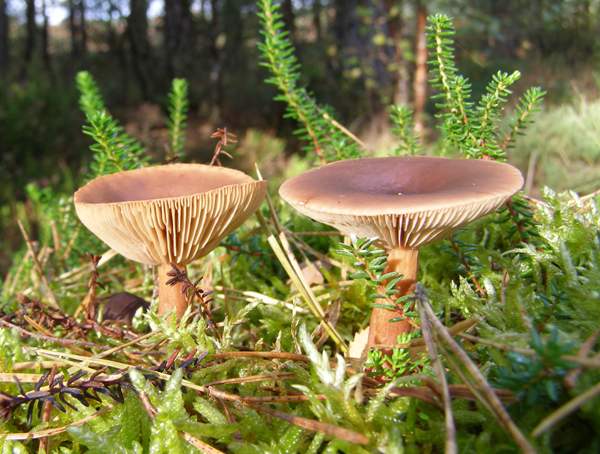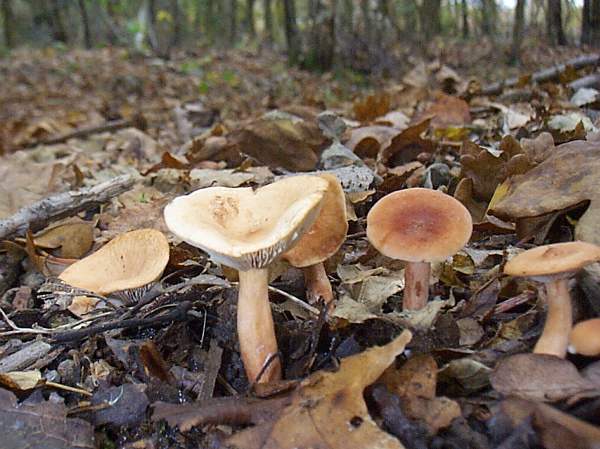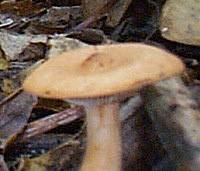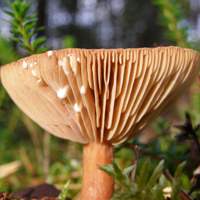Trees Birds Mammals Fish Amphibians Reptiles
Wild Algarve
Bookshop
Lactarius subdulcis (Pers.) Gray - Mild Milkcap
Phylum: Basidiomycota - Class: Agaricomycetes - Order: Russulales - Family: Russulaceae
Distribution - Taxonomic History - Etymology - Identification - Culinary Notes - Reference Sources

Another of the small milkcaps commonly found in broadleaf woods, Lactarius subdulcis is mycorrhizal with Beech trees, but it also occurs under birches and occasionally under deciduous oaks. This is a difficult milkcap to identify with certainty because is has so many lookalikes.
Distribution
Very common in Britain and Ireland as well as on mainland Europe, Lactarius subdulcis is not recorded in North America.

Caps of Lactarius subdulcis store abundant, sweet-tasting white milk.
Taxonomic history
The Mild Milkcap was described in 1801 by Christiaan Hendrik Persoon, who gave it the binomial scientific name Agaricus lactifluus var. subdulcis. (Vast numbers of gilled fungi were dumped into the Agaricus genus in the early days of fungal taxonomy; most have since been moved to other genera leaving in the present-day Agaricus genus a much smaller number of gilled mushrooms that are sometimes referred to as the 'true mushrooms'.) It was British mycologist Samuel Frederick Gray (1766 - 1828) who in 1821 transferred this species to the genus Lactarius and raised it to full species status as Lactarius subdulcis.
Synonyms of Lactarius subdulcis include Agaricus lactifluus var. subdulcis Pers.
Etymology
The generic name Lactarius means producing milk (lactating) - a reference to the milky latex that is exuded from the gills of milkcap fungi when they are cut or torn. The specific epithet subdulcis literally means 'under sweet' - a reference to the initial mild then sweet taste that is later followed by a slight bitterness.
Identification guide
 |
Cap
Variable from reddish-brown to dark cinnamon with a paler buff margin; convex, centre becoming depressed with a small umbo; 3 to 7cm across. |

|
Gills
White maturing to a pinkish buff; adnate or slightly decurrent; moderately crowded. Latex is white, unchanging; abundant; taste initially mild, becoming slightly bitter.
Stem
Slightly paler than the cap but much lighter at the apex; cylindrical, base slightly clavate; 4 to 7cm long, 0.6 to 1.3cm diameter; no stem ring. |
| |
Spores
Ellipsoidal, 7.5-9.5 x 6.5-8µm; ornamented with warts up to 1µm tall joined by narrow ridges to form a well-developed network.
Spore print
Cream with a slight salmon-pink tinge. |
Odour/taste |
No significant odour; taste initially mild and then sweet but eventually becoming slightly bitter and acrid. |
Habitat & Ecological role |
Mycorrhizal, under Beech trees and occasionally other hardwoods. |
Season |
August to November in Britain and Ireland. |
Occurrence |
Very common in Britain and Ireland as well as on mainland Europe, Lactarius subdulcis is not recorded in North America. |
Similar species |
Lactarius blennius, the Beech Milkcap, is much greyer. |
Culinary Notes
Lactarius
subdulcis is edible but it is not highly regarded because many superior, larger and more plentiful milkcap mushrooms fruit at the same time of the year in the same deciduous woodland habitats preferred by the Mild Milkcap.
Reference Sources
Pat O'Reilly (2016). Fascinated by Fungi, First Nature Publishing
Jacob Heilmann-Clausen, Annemieke Verbeken, & Jan Vesterholt (1998). The Genus Lactarius (Fungi of Northern Europe—Vol. 2) The Danish Mycological Society.
Funga Nordica, Henning Knudsen and Jan Vesterholt, 2008.
Fungi of Switzerland, volume 6: Russulaceae, Kränzlin, F.
BMS List of English Names for Fungi.
Paul M. Kirk, Paul F. Cannon, David W. Minter and J. A. Stalpers. (2008). Dictionary of the Fungi; CABI.
Taxonomic history and synonym information on these pages is drawn from many sources but in particular from the British Mycological Society's GB Checklist of Fungi.
Top of page...
Fascinated by Fungi. Back by popular demand, Pat O'Reilly's best-selling 450-page hardback book is available now. The latest second edition was republished with a sparkling new cover design in September 2022 by Coch-y-Bonddu Books. Full details and copies are available from the publisher's online bookshop...